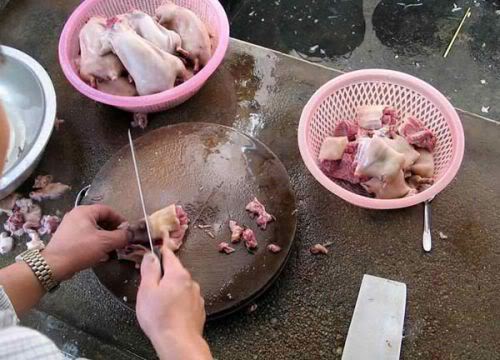
Have you ever wondered what rat meat would taste like?
Well, Chinese law enforcement has arrested over 900 people for selling rat and tainted meat in the past year.
This problem is not only in China, but it is also in England and Vietnam.
A lot of the black market meat, which England receives, comes from Africa.
As the poverty levels rise, people turn to poaching to make money for their families.
The poachers capture wild animals (some even being zebras, gorillas, and elephants) and then sell them. A typical lone poacher can capture about 50 animals a day, five or six of those would then be sold for use on the black market.
A lone poacher can capture about 50 animals a day, while an organized crime ring can capture hundreds of animals in one day.
So, why wouldn’t it be here in America?
This is what Leigh Henry, a senior policy officer for the World Wildlife Fund and the International Wildlife-Trade Monitoring Network (TRAFFIC), had to say:
“The United States is one of the world’s largest, if not the largest, consuming nations for wildlife products. This includes wildlife used for food, whether for cultural reasons or luxury markets. Since the demand continues, so does the trafficking.”
U.S. Customs and Border Patrol agents at Newark, New Jersey’s Liberty International Airport seized more than 19 pounds of antelope and rat meat from a passenger arriving from Uganda. The FDA feared that the meat was most likely going to small local restaurants.
There is other “bushmeat” (meat from African wildlife, including baboons, chimpanzees, and rats) that Americans might be consuming.
Last January, a study by the U.S. Pharmacopeial Convention (USP) found the number of records involving food fraud in the USP database is up by 60 percent.
In May of 2013, authorities arrested more than 60 traders in eastern China who bought rat, fox, and mink flesh and sold it as mutton. Much of the meat was destined for New York.
The arrests were part of a nationwide operation since late January to “attack food safety crimes and defend the safety of the dining table,” the Ministry of Public Security said. The police arrested 904 people suspected of selling fake, diseased, toxic or adulterated meat, and broke up 1,721 illicit factories, workshops, and shops. Yet the ministry acknowledges that diners still have reason to worry.
The U.S. Fish and Wildlife Service claims that 55 million pounds of “bushmeat” are exported into the U.S. each year, the majority of it ending up in New York, Florida, and California.
Often times rat meat is made to look like chicken by the way it is butchered, the average person would never know the difference.
The FDA says one of its largest concerns is diseases that many of these animals carry.
Some farmers in the pork industry claim that pig rectum is being sold in the U.S. as imitation calamari.
According to the FDA, they do not have enough resources to check all of the incoming food supply.
With their current resources, they can only check approximately 2.3 percent of all of the meat coming into America.
Even the furniture store IKEA hopped onto this bandwagon.
According to reports, IKEA’s European meatball supplier had up to 10 percent horsemeat in their meatballs.
According to IKEA, they use a different supplier for U.S. meatballs compared to their European meatballs.
Many, including Snopes.com, have pushed the use of rat meat as chicken off as an urban legend, but the FDA and the Ministry of Public Security says the issue in the U.S. is quite real. The FDA said Snopes.com is not a website consumers should go to for information when it concerns important health issues.
The Ministry says that many of the rats exported into the U.S. are not just wild rats, but also rats raised on farms. They said not one of the rodents will ever receive a vaccine for diseases before being sold.
A common dish that could possibly be prepared using rat meat is beef and chicken broccoli. According to experts, the meat in these two dishes is often rubbery, not like that of authentic chicken.
The FDA said that while every dish may not be prepared with rat meat, it is always a possibility.
The following video was shot in Vietnam.
—By Michael LaTulipe—
